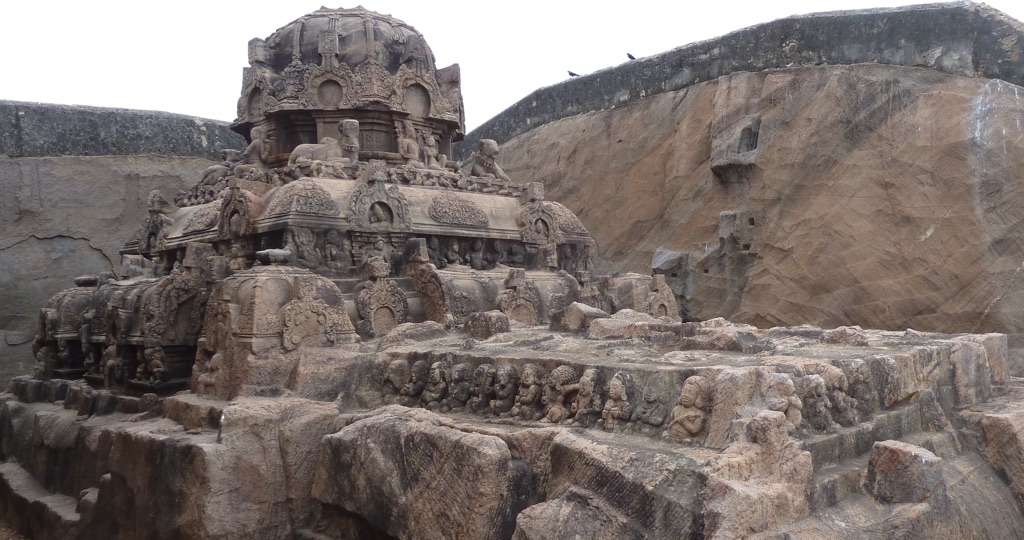The Vettuvan Koil rock cut temple is a remarkable example of Pandyan rock-cut architecture located in Kalugumalai, a panchayat town in Thoothukudi district in the South Indian state of Tamil Nadu. Carved out of a single rock, this unfinished temple stands as a testament to the exquisite craftsmanship of the ancient Pandyas. It is a monolithic structure, reflecting the skill and artistry that flourished during the 8th-9th century CE. The temple’s name, ‘Vettuvan Koil’, translates to ‘sculptor’s temple’, which is fitting given its intricate rock carvings and architectural beauty.
Get your dose of History via Email
Historical Background of The Vettuvan Koil Rock Cut Temple
The Vettuvan Koil rock cut temple dates back to the late 8th century, during the reign of the Pandyas. It was a period of great architectural activity in South India. The temple’s discovery is not well-documented, but it has been a subject of interest for historians and archaeologists for many years. The Pandyas, known for their rock-cut architecture, are credited with the temple’s construction. They have left behind a legacy of similar structures in the region, though Vettuvan Koil stands out for its unique design and craftsmanship.
There is no clear record of who exactly built the temple or commissioned its construction. However, it is widely accepted that it was created under the patronage of the Pandya rulers. The temple’s unfinished state provides a glimpse into the process of ancient temple-making, offering valuable insights into the techniques used by the sculptors of that era.
While the temple does not seem to have been inhabited, it has been an important site for local worship and pilgrimage over the centuries. The area around Kalugumalai has several other historical monuments, suggesting that it was a significant cultural and religious center during the Pandya dynasty.
The Vettuvan Koil rock cut temple has not been the scene of any historically significant events that are recorded. However, its very existence is significant as it represents the zenith of Pandyan architecture and the cultural importance of religion in ancient South Indian society.
The temple has attracted the attention of various scholars and continues to be a site of academic interest. Its historical importance is recognized by the Archaeological Survey of India, which maintains the site and has conducted several studies to understand its history and architecture better.
About The Vettuvan Koil Rock Cut Temple
The Vettuvan Koil rock cut temple is an unfinished monolithic temple, carved directly out of a single large rock. This architectural technique is known as ‘rock-cut architecture’, a method that was popular in various parts of India during ancient times. The temple’s design is characterized by intricate carvings and a planned layout that was never completed.
The temple’s structure includes a sanctum sanctorum, a main hall, and possibly an intended circumambulatory path around the sanctum. The rock carvings depict various deities and mythological scenes, showcasing the religious and mythological beliefs of the time. The carvings are fine examples of Pandyan art, with detailed and expressive figures.
The construction methods of the Vettuvan Koil rock cut temple involved chiseling and carving the rock from the top to the bottom. This technique required precise planning and execution, as mistakes could not be corrected once the rock was removed. The unfinished state of the temple offers a rare opportunity to study these ancient techniques.
Architectural highlights of the temple include the ornate pillars and the detailed reliefs on the walls. The style of the carvings suggests a blend of early Pandyan and Pallava architectural influences, which were prevalent in South India during that period.
The choice of material, being the natural rock on site, and the scale of the temple indicate the ambition and the resources that the Pandyas dedicated to religious architecture. The temple’s location also suggests that it was meant to be a prominent landmark in the region.
Theories and Interpretations
Several theories have been proposed regarding the purpose and the abrupt cessation of work at the Vettuvan Koil rock cut temple. Some suggest that the construction may have been halted due to a change in political power or a shift in religious focus. Others believe that the temple may have been a training ground for sculptors, given its name and unfinished state.
The temple’s use has been a subject of speculation. While it is clear that it was intended for religious purposes, the specific deities to which it was dedicated remain unknown. The carvings suggest a Hindu temple, but the exact sect or tradition it was associated with is not clear.
Mysteries surrounding the temple include the identities of the sculptors and the reasons for the temple’s incomplete state. The lack of historical records makes it difficult to draw definitive conclusions about these aspects of the temple’s history.
Historical records and architectural styles have been used to date the temple to the late 8th century. However, without explicit inscriptions or other definitive evidence, the exact date of construction remains an educated estimate.
Dating of the temple has relied on stylistic analysis and comparison with other similar structures in the region. The methods used include examining the style of carvings, the iconography, and the architectural features that are characteristic of the period.
At a glance
Country: India
Civilization: Pandya Dynasty
Age: 8th-9th century CE

